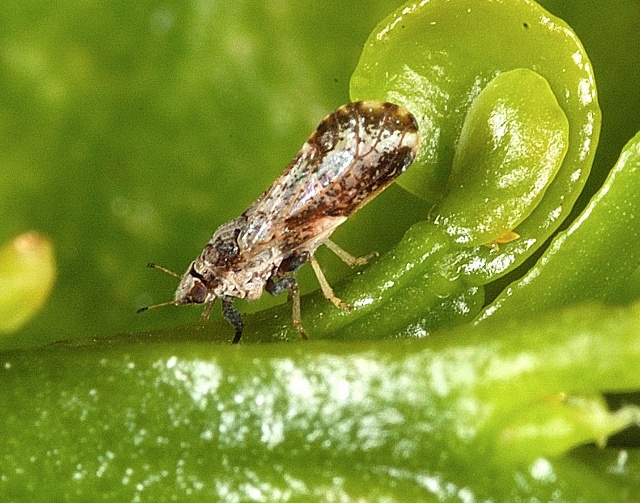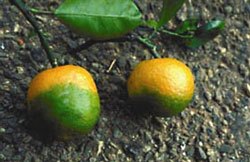Citrus Greening Disease Updates For 2017
What is citrus greening disease you ask?
It is a bacterial infection called Huanglongbing (HLB), that is spread by the Asian citrus psyllid insect and others. Once a tree is infected, the bacteria goes systemic and slowly kills the tree.
And both scientists and growers have been struggling to find a cure, fearful that we could lose the entire citrus industry in this country --- because the disease could not be stopped!

The Asian Citrus Psyllid is a sap-sucking bug . It is one of
only two known vectors
that spread the HLB bacteria
A bit of necessary history:
There are actually 3 different variations of HLB that we know of: an Asian variant, an African variant, and an American variant. It was first described in 1929, reported in China in 1943, reported in South Africa in 1947, and finally reported in Florida, USA in 2005. In 2012, it was found in both California & Texas as well.
There are differences in temperature sensitivity and vector transmission between the 3 types of HLB. These differences dictate different protocols in physically controlling the spread until a cure can be found. But for now, there is only one kind of greening in the US, so we limit our discussion to this issue.
Multi-faceted approach to control
There are 4 different kinds of citrus growers in FL and all are at a different point in the process of control of the disease. You have propagation growers, fresh fruit growers, juice market growers, and then homeowners.
In the short term, growers of propagation material have been controlling the spread by physically insulating their groves from the insects that spread the HLB. It's complicated. And expensive.
All new propagation is done in large, locked greenhouses -- greenhouses that can be as much as ten acres in size. Entrance to the greenhouse is buffeted by powerful fans that keep the bugs out. Fine mesh screening over the greenhouses let the sunshine in but not the bugs. Essentially, they build a psyllid-proof enclosure.
And any insult to the entire eco-system shuts the whole operation down until it is fixed -- courtesy of the friendly Department of Agriculture.
The growers for the fresh fruit market, and growers for the juice market may or may not be using as radical an approach, but all are struggling to protect the industry.
And then there's the rest of us: the homeowner-growers.
Searching for resolution.
Researchers at the University of Florida and other places are trying just about everything to come up with what they believe to be the best way(s) to stop the disease: Genome modification (GMO), developing new resistant varieties using painstaking conventional breeding, biological control, looking for chemicals to irradicate the insects that spread it, and finally looking for ways to improve the health of existing plants, both remedial & preventative.
GMO is a polarizing solution that isn't likely to ever achieve universal acceptance. At the risk of offending some of our readers, I suggest that 100 years from now it will join the long list of antiquated practices that looked promising but created so many other problems we abandoned it for a more desirable, environmentally friendly solution.

damaged fruit from an HLB infected tree
While breeding new resistant varieties is an exciting solution, it can be difficult to give up an old favorite. And new varieties take years to develop -- some take decades. Meantime . . .
And so far, biological control has proven to be insufficient to slow the spread of disease, at least when used exclusively.
Finding the next panacea chemical to erradicate the psyllids is another polarizing discussion that allienates the organic growers. Presently, powerful systemic insecticides are used to discourage psyllids -- imidacloprid being the most commonly used in Florida nurseries for insect control. It is a very toxic chemical and is applied to ALL young citrus trees leaving the propagation nurseries, whether they go to orchards or homeowners. Imidacloprid is harmful to the bees. And there are other host plants for the psyllid that also must be monitored in a crisis: orange jessamine (Murraya paniculata), orange boxwood (Severina buxifolia), and even Cherry of the Rio Grande.
For the homeowner, a preventive approach to insect control can be most helpful. The citrus inspectors tell us that insect pests generally attack in a predictable manner: Black aphids invade first, leaf miners second, followed by the citrus psyllid. So while the citrus psyllid is difficult to see, you can surely see it coming when the aphids attack.
We have used a broad spectrum organic insecticide called Organocide 3-in-1 at the first sign of black aphids and have avoided any further insect invasions to date, even though the disease is all around us. Yes, Neem is good for some kinds of bugs and powdery mildew but it is not as broad spectrum as Organocide 3-in-1. BTW, the active ingredient in Organocide is sesame oil.
And so that brings us to last category of potential solutions: nutritional therapies and organic protocols. Like the breeding of new resistant varieties, nutritional therapies take time to implement.
Please see the next post here for an in-depth look at nutritional solutions -- that are actually working!
Wrap Up:
With so many brilliant scientists working on this issue trying to save the Florida citrus industry, I believe it is only a matter of time before we have a working protocol that we can all agree with, to both save infected trees and control the spread of this bacteria. There are many bright spots in this research already. And personally, we favor the organic solutions because they are the most sustainable in the long run, without creating other problems for a future generation to solve.
